Strategic Analysis of Barclays Bank's Business Strategies
VerifiedAdded on 2020/09/08
|11
|3355
|238
Report
AI Summary
This report provides a detailed analysis of Barclays Bank's business strategies. It begins by defining strategic planning and the strategies employed by Barclays, including its focus on retail and wholesale banking. The report identifies challenges faced by the UK financial industry, such as Brexit and profitability concerns. It explores strategic implementation, comparing retail and wholesale banking organizations like Barclays and Standard Chartered. Furthermore, the report assesses the effectiveness of strategic models, particularly the Ansoff Matrix, used by Barclays for market penetration, product development, market development, and diversification. The analysis highlights how Barclays adapts its strategies to navigate the competitive landscape and address customer needs. The report concludes by summarizing the key findings regarding Barclays' strategic approaches and their impact on the bank's performance within the financial sector.
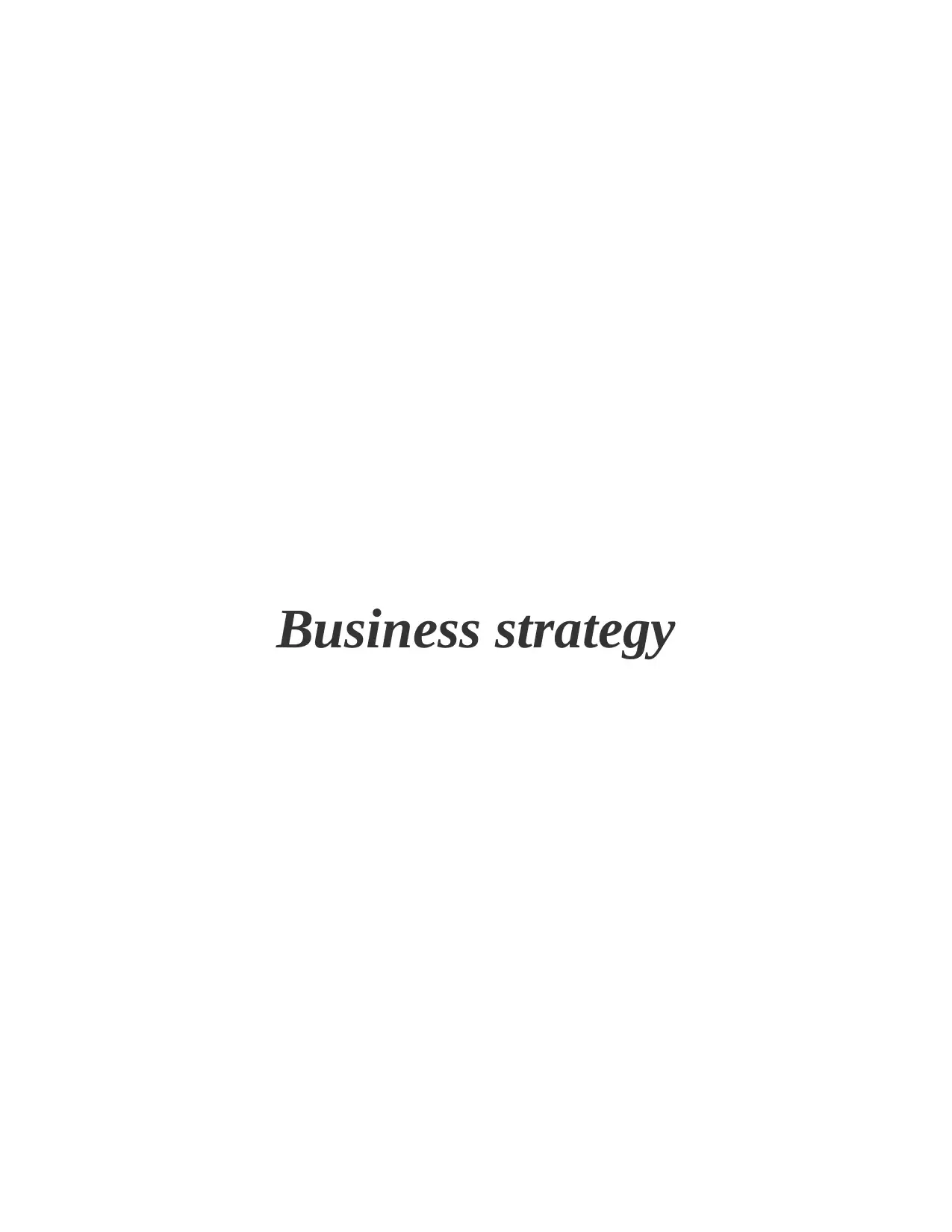
Business strategy
Paraphrase This Document
Need a fresh take? Get an instant paraphrase of this document with our AI Paraphraser
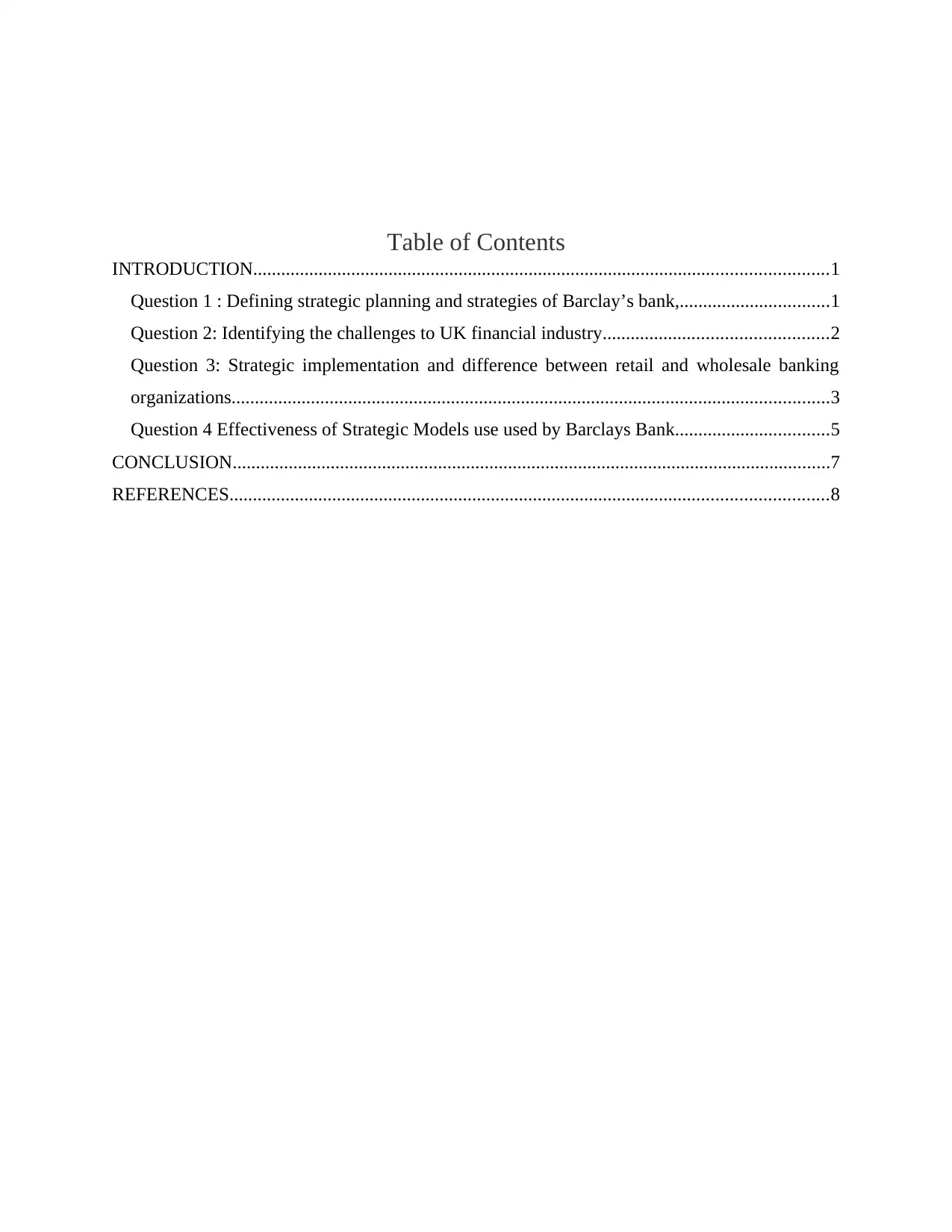
Table of Contents
INTRODUCTION...........................................................................................................................1
Question 1 : Defining strategic planning and strategies of Barclay’s bank,................................1
Question 2: Identifying the challenges to UK financial industry................................................2
Question 3: Strategic implementation and difference between retail and wholesale banking
organizations................................................................................................................................3
Question 4 Effectiveness of Strategic Models use used by Barclays Bank.................................5
CONCLUSION................................................................................................................................7
REFERENCES................................................................................................................................8
INTRODUCTION...........................................................................................................................1
Question 1 : Defining strategic planning and strategies of Barclay’s bank,................................1
Question 2: Identifying the challenges to UK financial industry................................................2
Question 3: Strategic implementation and difference between retail and wholesale banking
organizations................................................................................................................................3
Question 4 Effectiveness of Strategic Models use used by Barclays Bank.................................5
CONCLUSION................................................................................................................................7
REFERENCES................................................................................................................................8
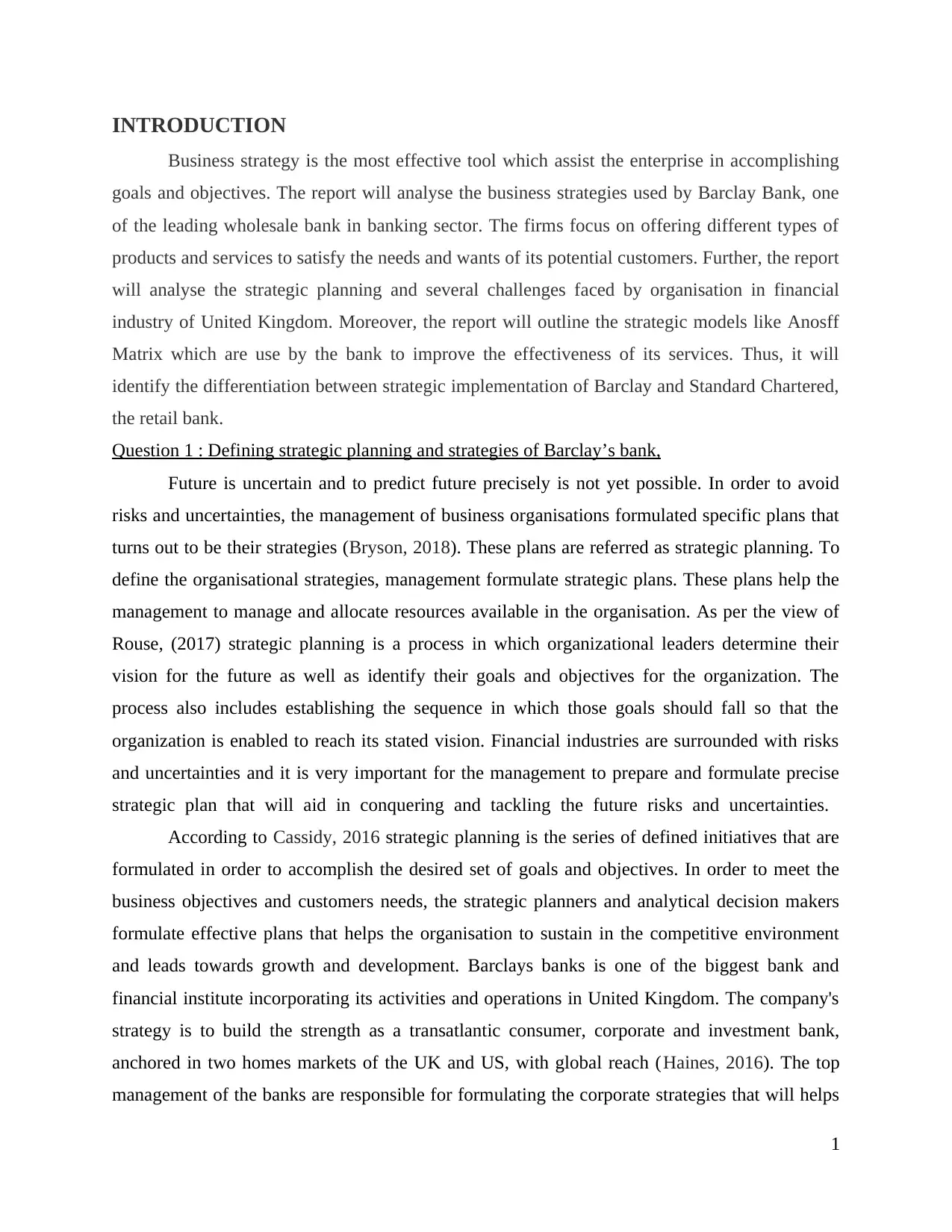
INTRODUCTION
Business strategy is the most effective tool which assist the enterprise in accomplishing
goals and objectives. The report will analyse the business strategies used by Barclay Bank, one
of the leading wholesale bank in banking sector. The firms focus on offering different types of
products and services to satisfy the needs and wants of its potential customers. Further, the report
will analyse the strategic planning and several challenges faced by organisation in financial
industry of United Kingdom. Moreover, the report will outline the strategic models like Anosff
Matrix which are use by the bank to improve the effectiveness of its services. Thus, it will
identify the differentiation between strategic implementation of Barclay and Standard Chartered,
the retail bank.
Question 1 : Defining strategic planning and strategies of Barclay’s bank,
Future is uncertain and to predict future precisely is not yet possible. In order to avoid
risks and uncertainties, the management of business organisations formulated specific plans that
turns out to be their strategies (Bryson, 2018). These plans are referred as strategic planning. To
define the organisational strategies, management formulate strategic plans. These plans help the
management to manage and allocate resources available in the organisation. As per the view of
Rouse, (2017) strategic planning is a process in which organizational leaders determine their
vision for the future as well as identify their goals and objectives for the organization. The
process also includes establishing the sequence in which those goals should fall so that the
organization is enabled to reach its stated vision. Financial industries are surrounded with risks
and uncertainties and it is very important for the management to prepare and formulate precise
strategic plan that will aid in conquering and tackling the future risks and uncertainties.
According to Cassidy, 2016 strategic planning is the series of defined initiatives that are
formulated in order to accomplish the desired set of goals and objectives. In order to meet the
business objectives and customers needs, the strategic planners and analytical decision makers
formulate effective plans that helps the organisation to sustain in the competitive environment
and leads towards growth and development. Barclays banks is one of the biggest bank and
financial institute incorporating its activities and operations in United Kingdom. The company's
strategy is to build the strength as a transatlantic consumer, corporate and investment bank,
anchored in two homes markets of the UK and US, with global reach (Haines, 2016). The top
management of the banks are responsible for formulating the corporate strategies that will helps
1
Business strategy is the most effective tool which assist the enterprise in accomplishing
goals and objectives. The report will analyse the business strategies used by Barclay Bank, one
of the leading wholesale bank in banking sector. The firms focus on offering different types of
products and services to satisfy the needs and wants of its potential customers. Further, the report
will analyse the strategic planning and several challenges faced by organisation in financial
industry of United Kingdom. Moreover, the report will outline the strategic models like Anosff
Matrix which are use by the bank to improve the effectiveness of its services. Thus, it will
identify the differentiation between strategic implementation of Barclay and Standard Chartered,
the retail bank.
Question 1 : Defining strategic planning and strategies of Barclay’s bank,
Future is uncertain and to predict future precisely is not yet possible. In order to avoid
risks and uncertainties, the management of business organisations formulated specific plans that
turns out to be their strategies (Bryson, 2018). These plans are referred as strategic planning. To
define the organisational strategies, management formulate strategic plans. These plans help the
management to manage and allocate resources available in the organisation. As per the view of
Rouse, (2017) strategic planning is a process in which organizational leaders determine their
vision for the future as well as identify their goals and objectives for the organization. The
process also includes establishing the sequence in which those goals should fall so that the
organization is enabled to reach its stated vision. Financial industries are surrounded with risks
and uncertainties and it is very important for the management to prepare and formulate precise
strategic plan that will aid in conquering and tackling the future risks and uncertainties.
According to Cassidy, 2016 strategic planning is the series of defined initiatives that are
formulated in order to accomplish the desired set of goals and objectives. In order to meet the
business objectives and customers needs, the strategic planners and analytical decision makers
formulate effective plans that helps the organisation to sustain in the competitive environment
and leads towards growth and development. Barclays banks is one of the biggest bank and
financial institute incorporating its activities and operations in United Kingdom. The company's
strategy is to build the strength as a transatlantic consumer, corporate and investment bank,
anchored in two homes markets of the UK and US, with global reach (Haines, 2016). The top
management of the banks are responsible for formulating the corporate strategies that will helps
1
⊘ This is a preview!⊘
Do you want full access?
Subscribe today to unlock all pages.

Trusted by 1+ million students worldwide
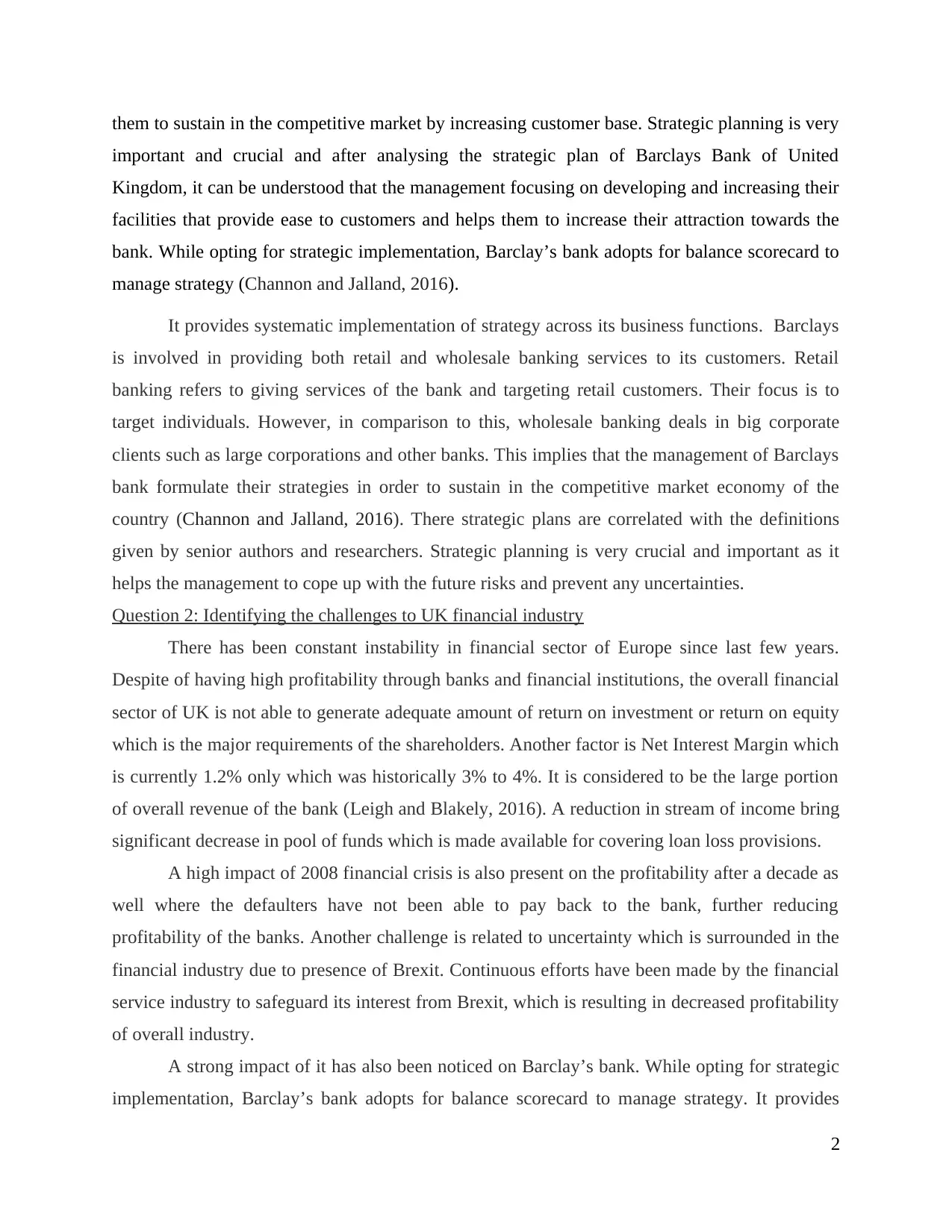
them to sustain in the competitive market by increasing customer base. Strategic planning is very
important and crucial and after analysing the strategic plan of Barclays Bank of United
Kingdom, it can be understood that the management focusing on developing and increasing their
facilities that provide ease to customers and helps them to increase their attraction towards the
bank. While opting for strategic implementation, Barclay’s bank adopts for balance scorecard to
manage strategy (Channon and Jalland, 2016).
It provides systematic implementation of strategy across its business functions. Barclays
is involved in providing both retail and wholesale banking services to its customers. Retail
banking refers to giving services of the bank and targeting retail customers. Their focus is to
target individuals. However, in comparison to this, wholesale banking deals in big corporate
clients such as large corporations and other banks. This implies that the management of Barclays
bank formulate their strategies in order to sustain in the competitive market economy of the
country (Channon and Jalland, 2016). There strategic plans are correlated with the definitions
given by senior authors and researchers. Strategic planning is very crucial and important as it
helps the management to cope up with the future risks and prevent any uncertainties.
Question 2: Identifying the challenges to UK financial industry
There has been constant instability in financial sector of Europe since last few years.
Despite of having high profitability through banks and financial institutions, the overall financial
sector of UK is not able to generate adequate amount of return on investment or return on equity
which is the major requirements of the shareholders. Another factor is Net Interest Margin which
is currently 1.2% only which was historically 3% to 4%. It is considered to be the large portion
of overall revenue of the bank (Leigh and Blakely, 2016). A reduction in stream of income bring
significant decrease in pool of funds which is made available for covering loan loss provisions.
A high impact of 2008 financial crisis is also present on the profitability after a decade as
well where the defaulters have not been able to pay back to the bank, further reducing
profitability of the banks. Another challenge is related to uncertainty which is surrounded in the
financial industry due to presence of Brexit. Continuous efforts have been made by the financial
service industry to safeguard its interest from Brexit, which is resulting in decreased profitability
of overall industry.
A strong impact of it has also been noticed on Barclay’s bank. While opting for strategic
implementation, Barclay’s bank adopts for balance scorecard to manage strategy. It provides
2
important and crucial and after analysing the strategic plan of Barclays Bank of United
Kingdom, it can be understood that the management focusing on developing and increasing their
facilities that provide ease to customers and helps them to increase their attraction towards the
bank. While opting for strategic implementation, Barclay’s bank adopts for balance scorecard to
manage strategy (Channon and Jalland, 2016).
It provides systematic implementation of strategy across its business functions. Barclays
is involved in providing both retail and wholesale banking services to its customers. Retail
banking refers to giving services of the bank and targeting retail customers. Their focus is to
target individuals. However, in comparison to this, wholesale banking deals in big corporate
clients such as large corporations and other banks. This implies that the management of Barclays
bank formulate their strategies in order to sustain in the competitive market economy of the
country (Channon and Jalland, 2016). There strategic plans are correlated with the definitions
given by senior authors and researchers. Strategic planning is very crucial and important as it
helps the management to cope up with the future risks and prevent any uncertainties.
Question 2: Identifying the challenges to UK financial industry
There has been constant instability in financial sector of Europe since last few years.
Despite of having high profitability through banks and financial institutions, the overall financial
sector of UK is not able to generate adequate amount of return on investment or return on equity
which is the major requirements of the shareholders. Another factor is Net Interest Margin which
is currently 1.2% only which was historically 3% to 4%. It is considered to be the large portion
of overall revenue of the bank (Leigh and Blakely, 2016). A reduction in stream of income bring
significant decrease in pool of funds which is made available for covering loan loss provisions.
A high impact of 2008 financial crisis is also present on the profitability after a decade as
well where the defaulters have not been able to pay back to the bank, further reducing
profitability of the banks. Another challenge is related to uncertainty which is surrounded in the
financial industry due to presence of Brexit. Continuous efforts have been made by the financial
service industry to safeguard its interest from Brexit, which is resulting in decreased profitability
of overall industry.
A strong impact of it has also been noticed on Barclay’s bank. While opting for strategic
implementation, Barclay’s bank adopts for balance scorecard to manage strategy. It provides
2
Paraphrase This Document
Need a fresh take? Get an instant paraphrase of this document with our AI Paraphraser
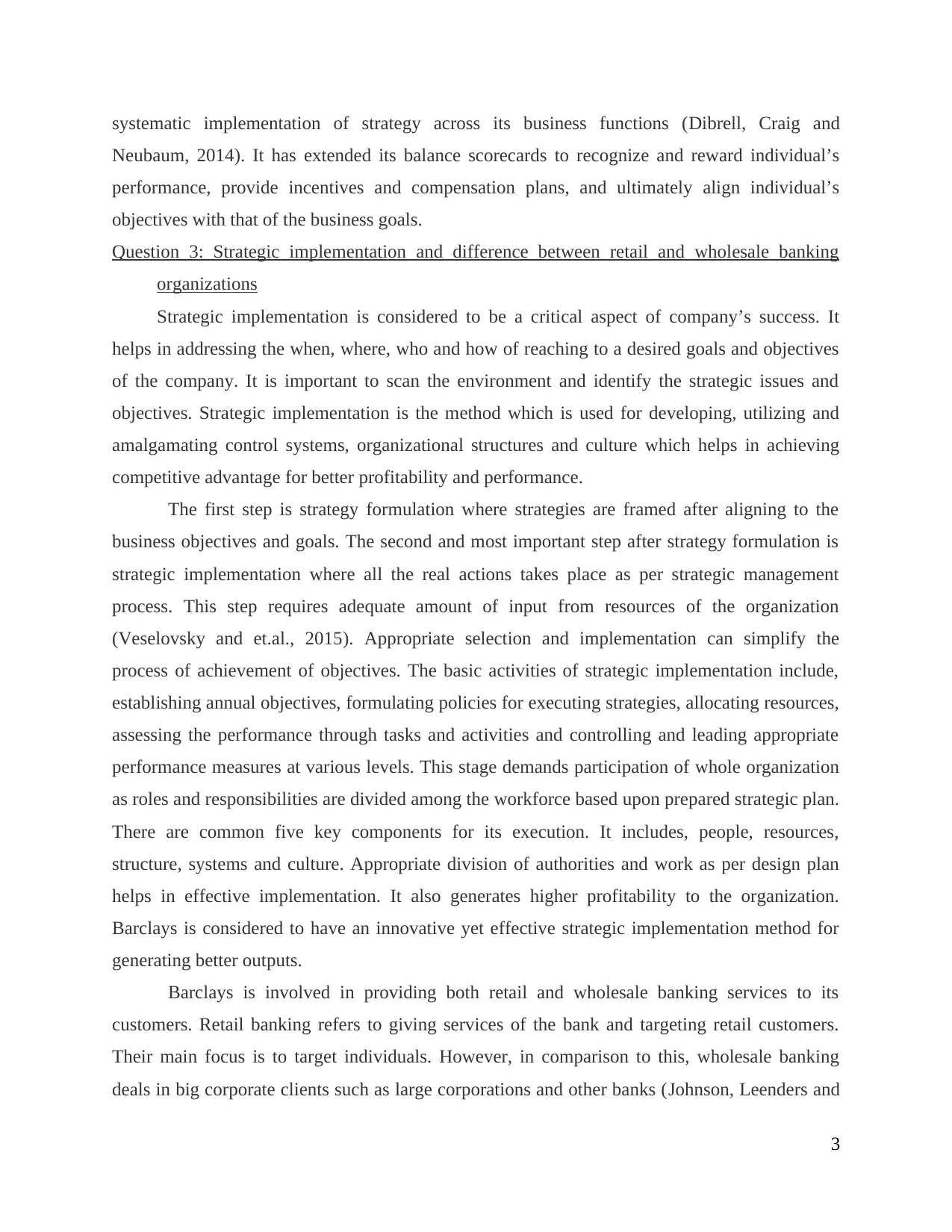
systematic implementation of strategy across its business functions (Dibrell, Craig and
Neubaum, 2014). It has extended its balance scorecards to recognize and reward individual’s
performance, provide incentives and compensation plans, and ultimately align individual’s
objectives with that of the business goals.
Question 3: Strategic implementation and difference between retail and wholesale banking
organizations
Strategic implementation is considered to be a critical aspect of company’s success. It
helps in addressing the when, where, who and how of reaching to a desired goals and objectives
of the company. It is important to scan the environment and identify the strategic issues and
objectives. Strategic implementation is the method which is used for developing, utilizing and
amalgamating control systems, organizational structures and culture which helps in achieving
competitive advantage for better profitability and performance.
The first step is strategy formulation where strategies are framed after aligning to the
business objectives and goals. The second and most important step after strategy formulation is
strategic implementation where all the real actions takes place as per strategic management
process. This step requires adequate amount of input from resources of the organization
(Veselovsky and et.al., 2015). Appropriate selection and implementation can simplify the
process of achievement of objectives. The basic activities of strategic implementation include,
establishing annual objectives, formulating policies for executing strategies, allocating resources,
assessing the performance through tasks and activities and controlling and leading appropriate
performance measures at various levels. This stage demands participation of whole organization
as roles and responsibilities are divided among the workforce based upon prepared strategic plan.
There are common five key components for its execution. It includes, people, resources,
structure, systems and culture. Appropriate division of authorities and work as per design plan
helps in effective implementation. It also generates higher profitability to the organization.
Barclays is considered to have an innovative yet effective strategic implementation method for
generating better outputs.
Barclays is involved in providing both retail and wholesale banking services to its
customers. Retail banking refers to giving services of the bank and targeting retail customers.
Their main focus is to target individuals. However, in comparison to this, wholesale banking
deals in big corporate clients such as large corporations and other banks (Johnson, Leenders and
3
Neubaum, 2014). It has extended its balance scorecards to recognize and reward individual’s
performance, provide incentives and compensation plans, and ultimately align individual’s
objectives with that of the business goals.
Question 3: Strategic implementation and difference between retail and wholesale banking
organizations
Strategic implementation is considered to be a critical aspect of company’s success. It
helps in addressing the when, where, who and how of reaching to a desired goals and objectives
of the company. It is important to scan the environment and identify the strategic issues and
objectives. Strategic implementation is the method which is used for developing, utilizing and
amalgamating control systems, organizational structures and culture which helps in achieving
competitive advantage for better profitability and performance.
The first step is strategy formulation where strategies are framed after aligning to the
business objectives and goals. The second and most important step after strategy formulation is
strategic implementation where all the real actions takes place as per strategic management
process. This step requires adequate amount of input from resources of the organization
(Veselovsky and et.al., 2015). Appropriate selection and implementation can simplify the
process of achievement of objectives. The basic activities of strategic implementation include,
establishing annual objectives, formulating policies for executing strategies, allocating resources,
assessing the performance through tasks and activities and controlling and leading appropriate
performance measures at various levels. This stage demands participation of whole organization
as roles and responsibilities are divided among the workforce based upon prepared strategic plan.
There are common five key components for its execution. It includes, people, resources,
structure, systems and culture. Appropriate division of authorities and work as per design plan
helps in effective implementation. It also generates higher profitability to the organization.
Barclays is considered to have an innovative yet effective strategic implementation method for
generating better outputs.
Barclays is involved in providing both retail and wholesale banking services to its
customers. Retail banking refers to giving services of the bank and targeting retail customers.
Their main focus is to target individuals. However, in comparison to this, wholesale banking
deals in big corporate clients such as large corporations and other banks (Johnson, Leenders and
3
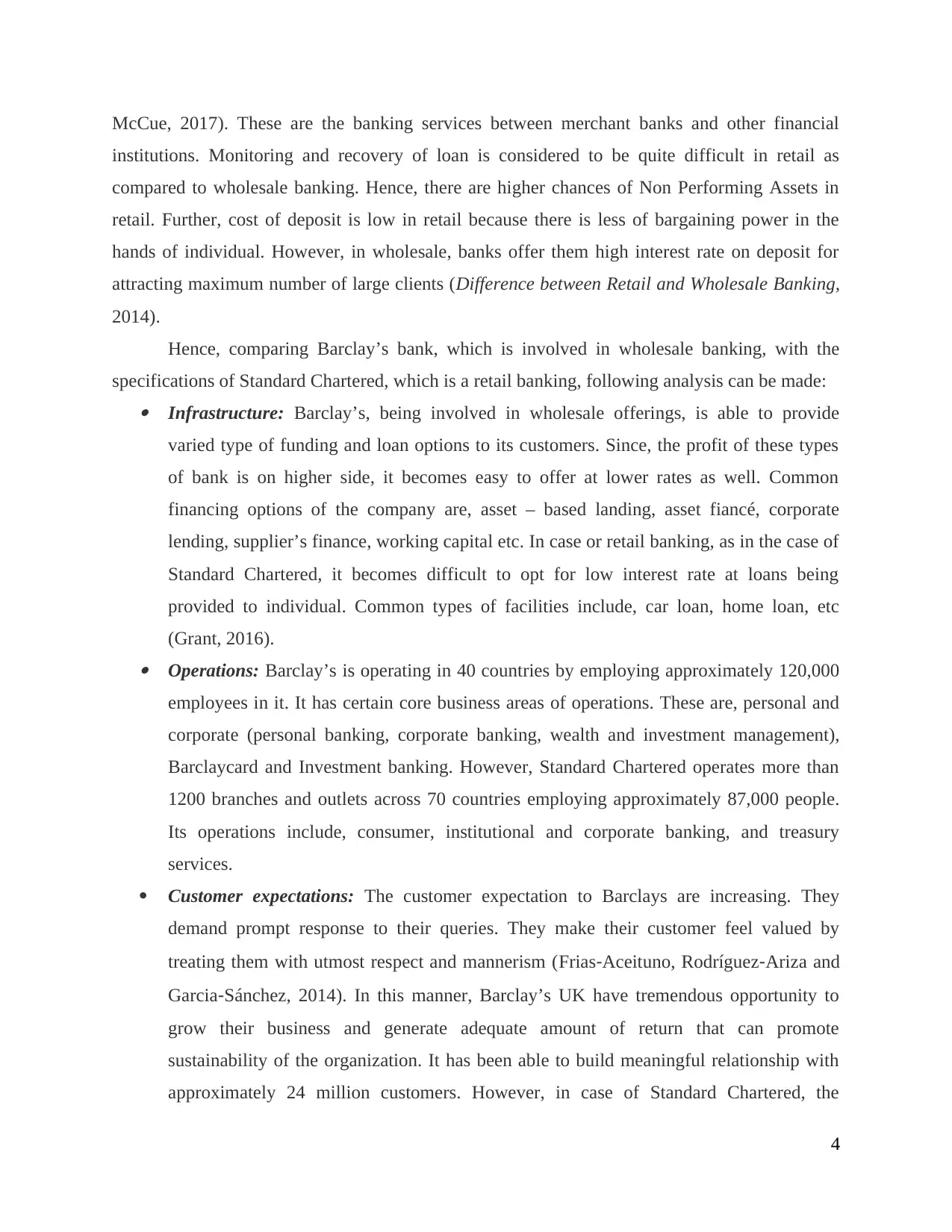
McCue, 2017). These are the banking services between merchant banks and other financial
institutions. Monitoring and recovery of loan is considered to be quite difficult in retail as
compared to wholesale banking. Hence, there are higher chances of Non Performing Assets in
retail. Further, cost of deposit is low in retail because there is less of bargaining power in the
hands of individual. However, in wholesale, banks offer them high interest rate on deposit for
attracting maximum number of large clients (Difference between Retail and Wholesale Banking,
2014).
Hence, comparing Barclay’s bank, which is involved in wholesale banking, with the
specifications of Standard Chartered, which is a retail banking, following analysis can be made: Infrastructure: Barclay’s, being involved in wholesale offerings, is able to provide
varied type of funding and loan options to its customers. Since, the profit of these types
of bank is on higher side, it becomes easy to offer at lower rates as well. Common
financing options of the company are, asset – based landing, asset fiancé, corporate
lending, supplier’s finance, working capital etc. In case or retail banking, as in the case of
Standard Chartered, it becomes difficult to opt for low interest rate at loans being
provided to individual. Common types of facilities include, car loan, home loan, etc
(Grant, 2016). Operations: Barclay’s is operating in 40 countries by employing approximately 120,000
employees in it. It has certain core business areas of operations. These are, personal and
corporate (personal banking, corporate banking, wealth and investment management),
Barclaycard and Investment banking. However, Standard Chartered operates more than
1200 branches and outlets across 70 countries employing approximately 87,000 people.
Its operations include, consumer, institutional and corporate banking, and treasury
services.
Customer expectations: The customer expectation to Barclays are increasing. They
demand prompt response to their queries. They make their customer feel valued by
treating them with utmost respect and mannerism (Frias‐Aceituno, Rodríguez‐Ariza and
Garcia‐Sánchez, 2014). In this manner, Barclay’s UK have tremendous opportunity to
grow their business and generate adequate amount of return that can promote
sustainability of the organization. It has been able to build meaningful relationship with
approximately 24 million customers. However, in case of Standard Chartered, the
4
institutions. Monitoring and recovery of loan is considered to be quite difficult in retail as
compared to wholesale banking. Hence, there are higher chances of Non Performing Assets in
retail. Further, cost of deposit is low in retail because there is less of bargaining power in the
hands of individual. However, in wholesale, banks offer them high interest rate on deposit for
attracting maximum number of large clients (Difference between Retail and Wholesale Banking,
2014).
Hence, comparing Barclay’s bank, which is involved in wholesale banking, with the
specifications of Standard Chartered, which is a retail banking, following analysis can be made: Infrastructure: Barclay’s, being involved in wholesale offerings, is able to provide
varied type of funding and loan options to its customers. Since, the profit of these types
of bank is on higher side, it becomes easy to offer at lower rates as well. Common
financing options of the company are, asset – based landing, asset fiancé, corporate
lending, supplier’s finance, working capital etc. In case or retail banking, as in the case of
Standard Chartered, it becomes difficult to opt for low interest rate at loans being
provided to individual. Common types of facilities include, car loan, home loan, etc
(Grant, 2016). Operations: Barclay’s is operating in 40 countries by employing approximately 120,000
employees in it. It has certain core business areas of operations. These are, personal and
corporate (personal banking, corporate banking, wealth and investment management),
Barclaycard and Investment banking. However, Standard Chartered operates more than
1200 branches and outlets across 70 countries employing approximately 87,000 people.
Its operations include, consumer, institutional and corporate banking, and treasury
services.
Customer expectations: The customer expectation to Barclays are increasing. They
demand prompt response to their queries. They make their customer feel valued by
treating them with utmost respect and mannerism (Frias‐Aceituno, Rodríguez‐Ariza and
Garcia‐Sánchez, 2014). In this manner, Barclay’s UK have tremendous opportunity to
grow their business and generate adequate amount of return that can promote
sustainability of the organization. It has been able to build meaningful relationship with
approximately 24 million customers. However, in case of Standard Chartered, the
4
⊘ This is a preview!⊘
Do you want full access?
Subscribe today to unlock all pages.

Trusted by 1+ million students worldwide
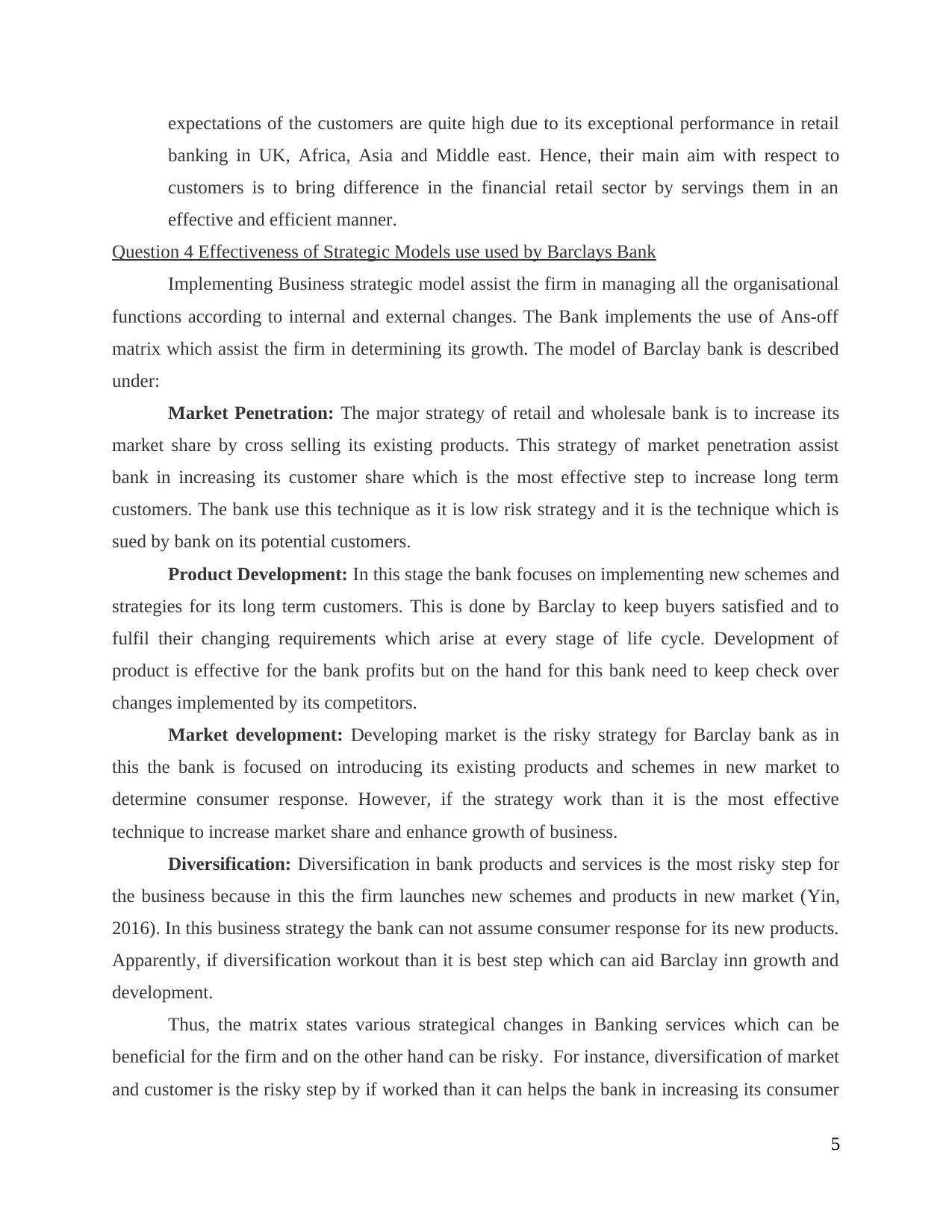
expectations of the customers are quite high due to its exceptional performance in retail
banking in UK, Africa, Asia and Middle east. Hence, their main aim with respect to
customers is to bring difference in the financial retail sector by servings them in an
effective and efficient manner.
Question 4 Effectiveness of Strategic Models use used by Barclays Bank
Implementing Business strategic model assist the firm in managing all the organisational
functions according to internal and external changes. The Bank implements the use of Ans-off
matrix which assist the firm in determining its growth. The model of Barclay bank is described
under:
Market Penetration: The major strategy of retail and wholesale bank is to increase its
market share by cross selling its existing products. This strategy of market penetration assist
bank in increasing its customer share which is the most effective step to increase long term
customers. The bank use this technique as it is low risk strategy and it is the technique which is
sued by bank on its potential customers.
Product Development: In this stage the bank focuses on implementing new schemes and
strategies for its long term customers. This is done by Barclay to keep buyers satisfied and to
fulfil their changing requirements which arise at every stage of life cycle. Development of
product is effective for the bank profits but on the hand for this bank need to keep check over
changes implemented by its competitors.
Market development: Developing market is the risky strategy for Barclay bank as in
this the bank is focused on introducing its existing products and schemes in new market to
determine consumer response. However, if the strategy work than it is the most effective
technique to increase market share and enhance growth of business.
Diversification: Diversification in bank products and services is the most risky step for
the business because in this the firm launches new schemes and products in new market (Yin,
2016). In this business strategy the bank can not assume consumer response for its new products.
Apparently, if diversification workout than it is best step which can aid Barclay inn growth and
development.
Thus, the matrix states various strategical changes in Banking services which can be
beneficial for the firm and on the other hand can be risky. For instance, diversification of market
and customer is the risky step by if worked than it can helps the bank in increasing its consumer
5
banking in UK, Africa, Asia and Middle east. Hence, their main aim with respect to
customers is to bring difference in the financial retail sector by servings them in an
effective and efficient manner.
Question 4 Effectiveness of Strategic Models use used by Barclays Bank
Implementing Business strategic model assist the firm in managing all the organisational
functions according to internal and external changes. The Bank implements the use of Ans-off
matrix which assist the firm in determining its growth. The model of Barclay bank is described
under:
Market Penetration: The major strategy of retail and wholesale bank is to increase its
market share by cross selling its existing products. This strategy of market penetration assist
bank in increasing its customer share which is the most effective step to increase long term
customers. The bank use this technique as it is low risk strategy and it is the technique which is
sued by bank on its potential customers.
Product Development: In this stage the bank focuses on implementing new schemes and
strategies for its long term customers. This is done by Barclay to keep buyers satisfied and to
fulfil their changing requirements which arise at every stage of life cycle. Development of
product is effective for the bank profits but on the hand for this bank need to keep check over
changes implemented by its competitors.
Market development: Developing market is the risky strategy for Barclay bank as in
this the bank is focused on introducing its existing products and schemes in new market to
determine consumer response. However, if the strategy work than it is the most effective
technique to increase market share and enhance growth of business.
Diversification: Diversification in bank products and services is the most risky step for
the business because in this the firm launches new schemes and products in new market (Yin,
2016). In this business strategy the bank can not assume consumer response for its new products.
Apparently, if diversification workout than it is best step which can aid Barclay inn growth and
development.
Thus, the matrix states various strategical changes in Banking services which can be
beneficial for the firm and on the other hand can be risky. For instance, diversification of market
and customer is the risky step by if worked than it can helps the bank in increasing its consumer
5
Paraphrase This Document
Need a fresh take? Get an instant paraphrase of this document with our AI Paraphraser
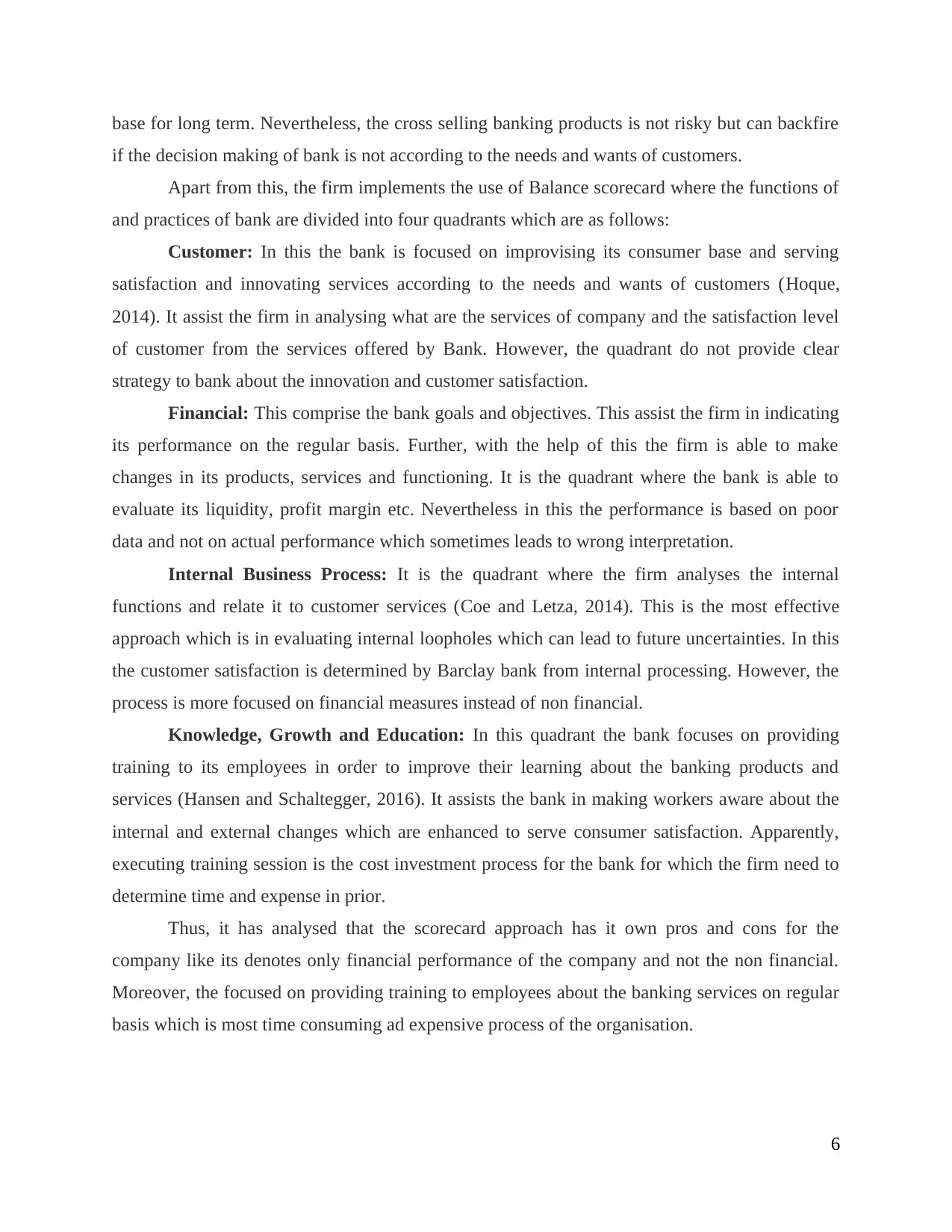
base for long term. Nevertheless, the cross selling banking products is not risky but can backfire
if the decision making of bank is not according to the needs and wants of customers.
Apart from this, the firm implements the use of Balance scorecard where the functions of
and practices of bank are divided into four quadrants which are as follows:
Customer: In this the bank is focused on improvising its consumer base and serving
satisfaction and innovating services according to the needs and wants of customers (Hoque,
2014). It assist the firm in analysing what are the services of company and the satisfaction level
of customer from the services offered by Bank. However, the quadrant do not provide clear
strategy to bank about the innovation and customer satisfaction.
Financial: This comprise the bank goals and objectives. This assist the firm in indicating
its performance on the regular basis. Further, with the help of this the firm is able to make
changes in its products, services and functioning. It is the quadrant where the bank is able to
evaluate its liquidity, profit margin etc. Nevertheless in this the performance is based on poor
data and not on actual performance which sometimes leads to wrong interpretation.
Internal Business Process: It is the quadrant where the firm analyses the internal
functions and relate it to customer services (Coe and Letza, 2014). This is the most effective
approach which is in evaluating internal loopholes which can lead to future uncertainties. In this
the customer satisfaction is determined by Barclay bank from internal processing. However, the
process is more focused on financial measures instead of non financial.
Knowledge, Growth and Education: In this quadrant the bank focuses on providing
training to its employees in order to improve their learning about the banking products and
services (Hansen and Schaltegger, 2016). It assists the bank in making workers aware about the
internal and external changes which are enhanced to serve consumer satisfaction. Apparently,
executing training session is the cost investment process for the bank for which the firm need to
determine time and expense in prior.
Thus, it has analysed that the scorecard approach has it own pros and cons for the
company like its denotes only financial performance of the company and not the non financial.
Moreover, the focused on providing training to employees about the banking services on regular
basis which is most time consuming ad expensive process of the organisation.
6
if the decision making of bank is not according to the needs and wants of customers.
Apart from this, the firm implements the use of Balance scorecard where the functions of
and practices of bank are divided into four quadrants which are as follows:
Customer: In this the bank is focused on improvising its consumer base and serving
satisfaction and innovating services according to the needs and wants of customers (Hoque,
2014). It assist the firm in analysing what are the services of company and the satisfaction level
of customer from the services offered by Bank. However, the quadrant do not provide clear
strategy to bank about the innovation and customer satisfaction.
Financial: This comprise the bank goals and objectives. This assist the firm in indicating
its performance on the regular basis. Further, with the help of this the firm is able to make
changes in its products, services and functioning. It is the quadrant where the bank is able to
evaluate its liquidity, profit margin etc. Nevertheless in this the performance is based on poor
data and not on actual performance which sometimes leads to wrong interpretation.
Internal Business Process: It is the quadrant where the firm analyses the internal
functions and relate it to customer services (Coe and Letza, 2014). This is the most effective
approach which is in evaluating internal loopholes which can lead to future uncertainties. In this
the customer satisfaction is determined by Barclay bank from internal processing. However, the
process is more focused on financial measures instead of non financial.
Knowledge, Growth and Education: In this quadrant the bank focuses on providing
training to its employees in order to improve their learning about the banking products and
services (Hansen and Schaltegger, 2016). It assists the bank in making workers aware about the
internal and external changes which are enhanced to serve consumer satisfaction. Apparently,
executing training session is the cost investment process for the bank for which the firm need to
determine time and expense in prior.
Thus, it has analysed that the scorecard approach has it own pros and cons for the
company like its denotes only financial performance of the company and not the non financial.
Moreover, the focused on providing training to employees about the banking services on regular
basis which is most time consuming ad expensive process of the organisation.
6
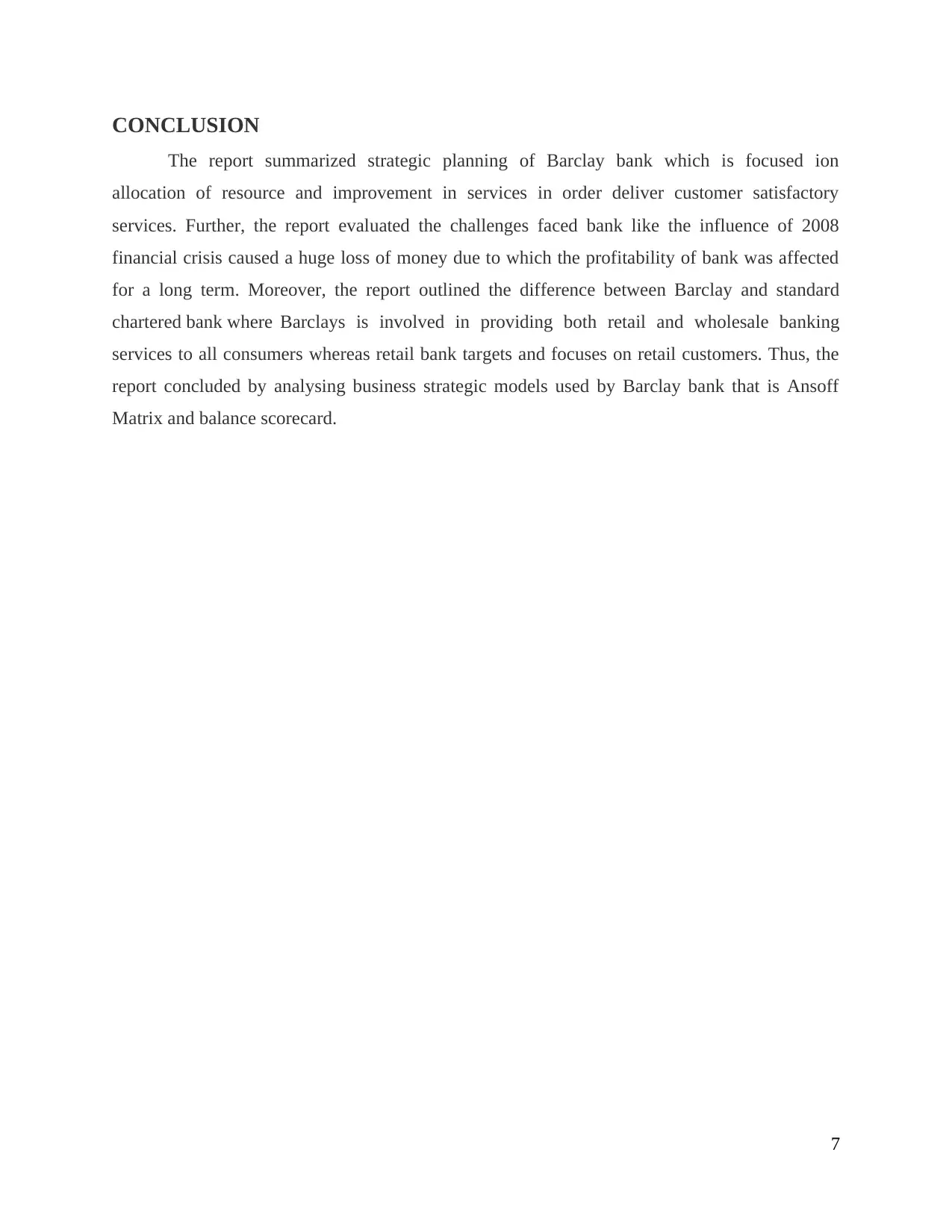
CONCLUSION
The report summarized strategic planning of Barclay bank which is focused ion
allocation of resource and improvement in services in order deliver customer satisfactory
services. Further, the report evaluated the challenges faced bank like the influence of 2008
financial crisis caused a huge loss of money due to which the profitability of bank was affected
for a long term. Moreover, the report outlined the difference between Barclay and standard
chartered bank where Barclays is involved in providing both retail and wholesale banking
services to all consumers whereas retail bank targets and focuses on retail customers. Thus, the
report concluded by analysing business strategic models used by Barclay bank that is Ansoff
Matrix and balance scorecard.
7
The report summarized strategic planning of Barclay bank which is focused ion
allocation of resource and improvement in services in order deliver customer satisfactory
services. Further, the report evaluated the challenges faced bank like the influence of 2008
financial crisis caused a huge loss of money due to which the profitability of bank was affected
for a long term. Moreover, the report outlined the difference between Barclay and standard
chartered bank where Barclays is involved in providing both retail and wholesale banking
services to all consumers whereas retail bank targets and focuses on retail customers. Thus, the
report concluded by analysing business strategic models used by Barclay bank that is Ansoff
Matrix and balance scorecard.
7
⊘ This is a preview!⊘
Do you want full access?
Subscribe today to unlock all pages.

Trusted by 1+ million students worldwide
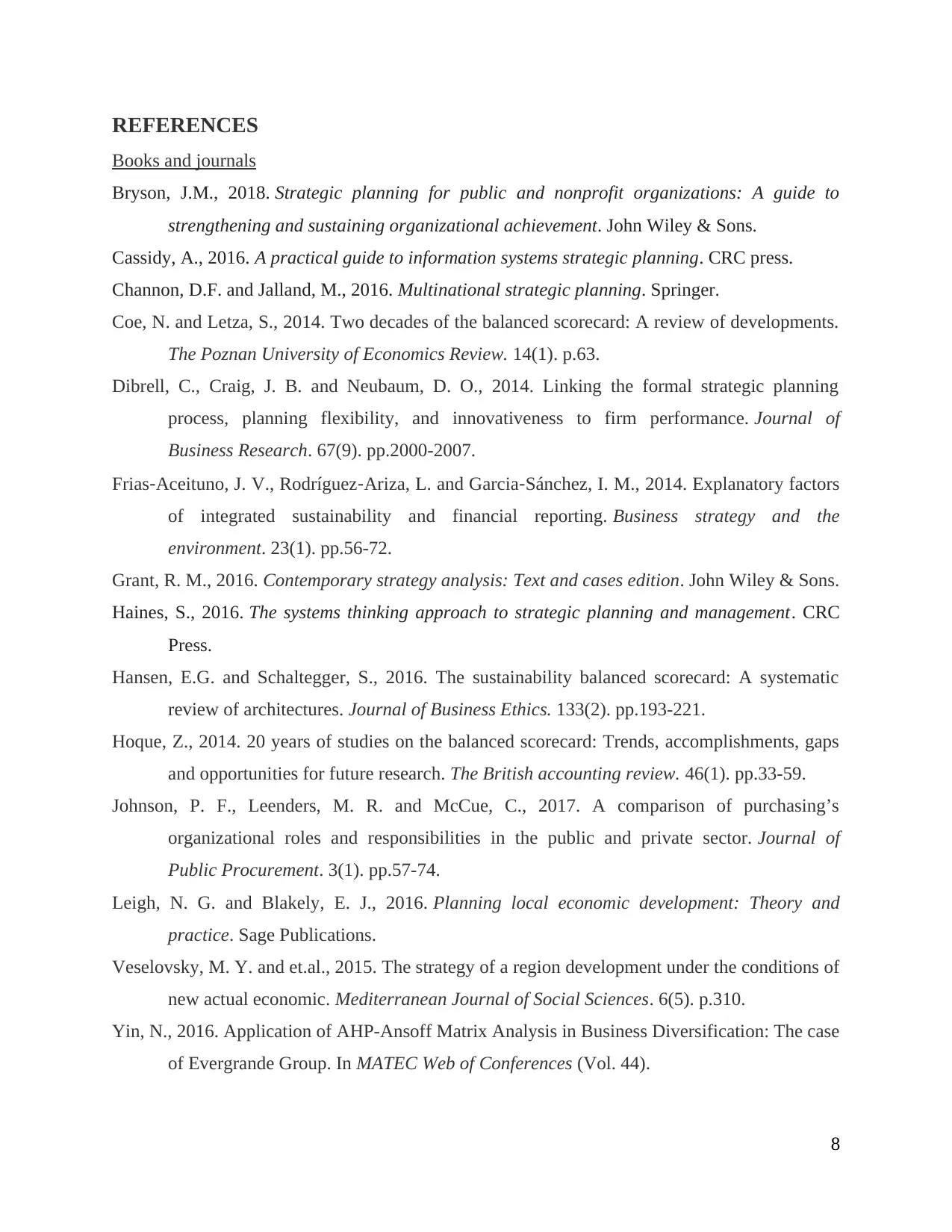
REFERENCES
Books and journals
Bryson, J.M., 2018. Strategic planning for public and nonprofit organizations: A guide to
strengthening and sustaining organizational achievement. John Wiley & Sons.
Cassidy, A., 2016. A practical guide to information systems strategic planning. CRC press.
Channon, D.F. and Jalland, M., 2016. Multinational strategic planning. Springer.
Coe, N. and Letza, S., 2014. Two decades of the balanced scorecard: A review of developments.
The Poznan University of Economics Review. 14(1). p.63.
Dibrell, C., Craig, J. B. and Neubaum, D. O., 2014. Linking the formal strategic planning
process, planning flexibility, and innovativeness to firm performance. Journal of
Business Research. 67(9). pp.2000-2007.
Frias‐Aceituno, J. V., Rodríguez‐Ariza, L. and Garcia‐Sánchez, I. M., 2014. Explanatory factors
of integrated sustainability and financial reporting. Business strategy and the
environment. 23(1). pp.56-72.
Grant, R. M., 2016. Contemporary strategy analysis: Text and cases edition. John Wiley & Sons.
Haines, S., 2016. The systems thinking approach to strategic planning and management. CRC
Press.
Hansen, E.G. and Schaltegger, S., 2016. The sustainability balanced scorecard: A systematic
review of architectures. Journal of Business Ethics. 133(2). pp.193-221.
Hoque, Z., 2014. 20 years of studies on the balanced scorecard: Trends, accomplishments, gaps
and opportunities for future research. The British accounting review. 46(1). pp.33-59.
Johnson, P. F., Leenders, M. R. and McCue, C., 2017. A comparison of purchasing’s
organizational roles and responsibilities in the public and private sector. Journal of
Public Procurement. 3(1). pp.57-74.
Leigh, N. G. and Blakely, E. J., 2016. Planning local economic development: Theory and
practice. Sage Publications.
Veselovsky, M. Y. and et.al., 2015. The strategy of a region development under the conditions of
new actual economic. Mediterranean Journal of Social Sciences. 6(5). p.310.
Yin, N., 2016. Application of AHP-Ansoff Matrix Analysis in Business Diversification: The case
of Evergrande Group. In MATEC Web of Conferences (Vol. 44).
8
Books and journals
Bryson, J.M., 2018. Strategic planning for public and nonprofit organizations: A guide to
strengthening and sustaining organizational achievement. John Wiley & Sons.
Cassidy, A., 2016. A practical guide to information systems strategic planning. CRC press.
Channon, D.F. and Jalland, M., 2016. Multinational strategic planning. Springer.
Coe, N. and Letza, S., 2014. Two decades of the balanced scorecard: A review of developments.
The Poznan University of Economics Review. 14(1). p.63.
Dibrell, C., Craig, J. B. and Neubaum, D. O., 2014. Linking the formal strategic planning
process, planning flexibility, and innovativeness to firm performance. Journal of
Business Research. 67(9). pp.2000-2007.
Frias‐Aceituno, J. V., Rodríguez‐Ariza, L. and Garcia‐Sánchez, I. M., 2014. Explanatory factors
of integrated sustainability and financial reporting. Business strategy and the
environment. 23(1). pp.56-72.
Grant, R. M., 2016. Contemporary strategy analysis: Text and cases edition. John Wiley & Sons.
Haines, S., 2016. The systems thinking approach to strategic planning and management. CRC
Press.
Hansen, E.G. and Schaltegger, S., 2016. The sustainability balanced scorecard: A systematic
review of architectures. Journal of Business Ethics. 133(2). pp.193-221.
Hoque, Z., 2014. 20 years of studies on the balanced scorecard: Trends, accomplishments, gaps
and opportunities for future research. The British accounting review. 46(1). pp.33-59.
Johnson, P. F., Leenders, M. R. and McCue, C., 2017. A comparison of purchasing’s
organizational roles and responsibilities in the public and private sector. Journal of
Public Procurement. 3(1). pp.57-74.
Leigh, N. G. and Blakely, E. J., 2016. Planning local economic development: Theory and
practice. Sage Publications.
Veselovsky, M. Y. and et.al., 2015. The strategy of a region development under the conditions of
new actual economic. Mediterranean Journal of Social Sciences. 6(5). p.310.
Yin, N., 2016. Application of AHP-Ansoff Matrix Analysis in Business Diversification: The case
of Evergrande Group. In MATEC Web of Conferences (Vol. 44).
8
Paraphrase This Document
Need a fresh take? Get an instant paraphrase of this document with our AI Paraphraser
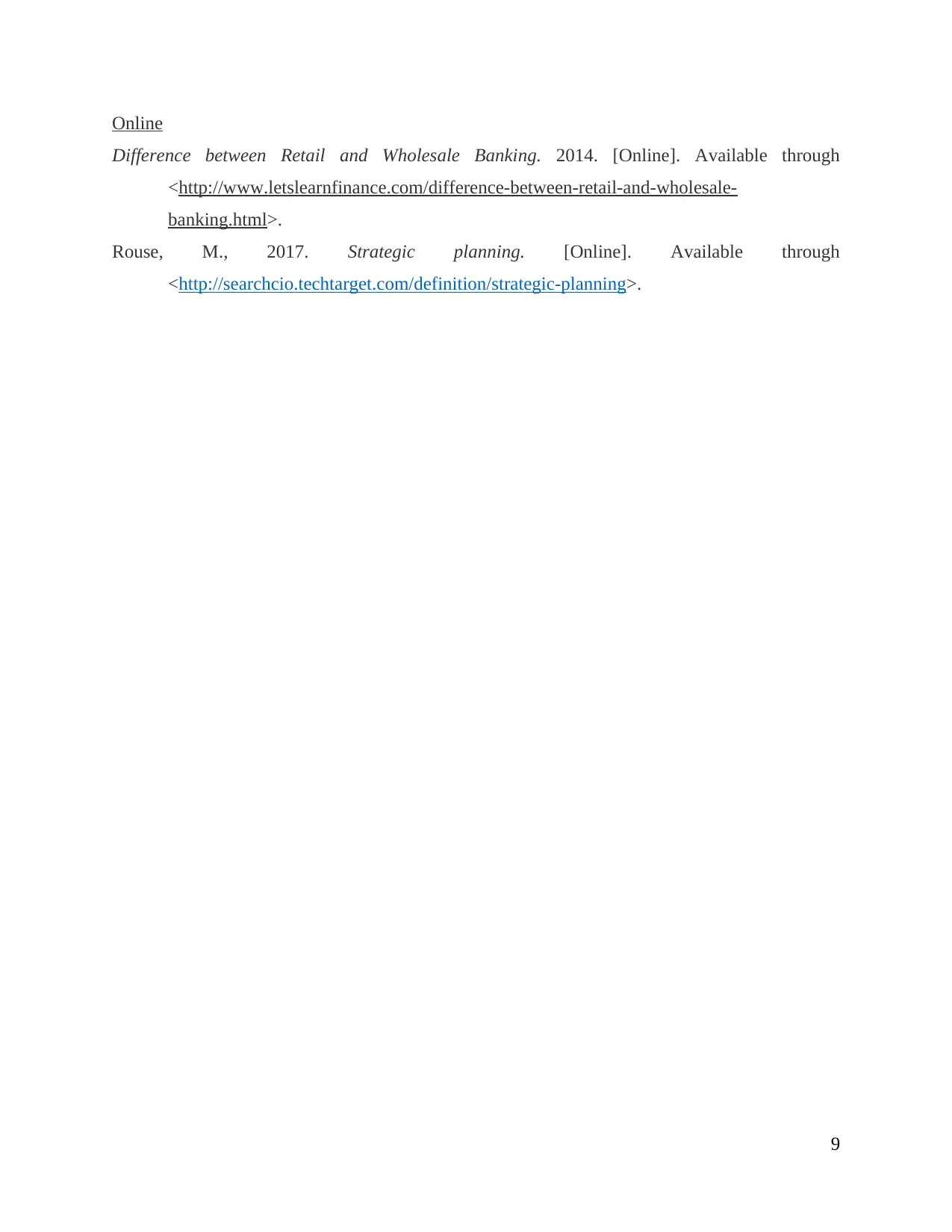
Online
Difference between Retail and Wholesale Banking. 2014. [Online]. Available through
<http://www.letslearnfinance.com/difference-between-retail-and-wholesale-
banking.html>.
Rouse, M., 2017. Strategic planning. [Online]. Available through
<http://searchcio.techtarget.com/definition/strategic-planning>.
9
Difference between Retail and Wholesale Banking. 2014. [Online]. Available through
<http://www.letslearnfinance.com/difference-between-retail-and-wholesale-
banking.html>.
Rouse, M., 2017. Strategic planning. [Online]. Available through
<http://searchcio.techtarget.com/definition/strategic-planning>.
9
1 out of 11
Related Documents
Your All-in-One AI-Powered Toolkit for Academic Success.
+13062052269
info@desklib.com
Available 24*7 on WhatsApp / Email
![[object Object]](/_next/static/media/star-bottom.7253800d.svg)
Unlock your academic potential
Copyright © 2020–2025 A2Z Services. All Rights Reserved. Developed and managed by ZUCOL.




